
In late August, a robot planted a cover crop into a two-acre plot of maturing corn on Dean Thomas’s southeast Minnesota farm.Equipped with an air seeder, the “Rowbot” planted three rows per pass of a cover crop seed mix. The machine provided “pretty decent coverage,” says Thomas, a cover crops expert at the Fillmore County Soil and Water Conservation District. Although there are some bugs still to be worked out, “I think it’s got good potential.”The ability to plant between rows in a cash crop before harvest is an advantage, says Thomas. The cover crop has more time to grow before freeze-up and there are more seed choices.
December 17, 2014

A big challenge – nitrogen management – could have a small solution. Rowbot Systems, a Minneapolis startup company, has developed an multi-platform robot that, among other things, can side-dress nitrogen in tall corn. The high-tech firm, founded in 2012, demonstrated a prototype robot last summer in Minnesota and Illinois farm fields.
The self-driving, GPS-linked “Rowbot” fits between corn rows. Equipped with four-wheel drive and an articulating chassis, the machine is built to traverse rugged terrain without getting stuck.
Sophisticated sensors – the same technology used in Google’s driverless car – let the autonomous robot “see” to navigate, turn and detect obstacles such as tile intakes. The machine carries 40 gallons of urea/ammonium nitrate (UAN) fertilizer, which it sprays four rows at a time near the base of corn plants.
Growers are often reluctant to split-apply nitrogen in mid-season, a recognized best management practice, because of timing and labor challenges, soil conditions and the risk of crop damage from heavy machinery, says Kent Cavender-Bares, Rowbot co-founder and CEO. “We looked at this problem and asked, what happens if we go small?”
The first Rowbot model, designed for 30-inch rows, is not constrained by crop height, so growers can spoon-feed nitrogen fertilizer later in the season. That boosts nitrogen-use efficiency and yields while cutting the risk of nutrient losses to the environment, Cavender-Bares says.
The technology is flexible enough for other field tasks too, such as interseeding cover crops and, eventually, spraying fungicide under the canopy.
The Rowbot is being developed with over $2 million in investor seed money by Cavender-Bares and his brother John, a robotics engineer, and brother Charlie, a dairy farmer, in partnership with Carnegie Robotics in Pittsburgh.
The inventors ran their first field trials with the Rowbot in late July on a 40-acre section of Mark Lenort’s continuous cornfield near Fairmont, Minn. Guided by its sensors and Lenort’s as-planted map, the robot applied 30 lbs./acre of nitrogen as UAN 28% in the root zone just before tasseling.
A shot of nitrogen mid-season can boost corn yields, says Lenort’s agronomist, Ryan Adams, Crop Production Systems, Fairmont. This is especially true if heavy rains have raised the risk of leaching or denitrification, as in 2014.
The Rowbot is still in the development stage. Eventually, the company envisions putting a fleet of networked Rowbots in a field to provide the same efficiency as conventional application systems.
About the Author(s)
You May Also Like



